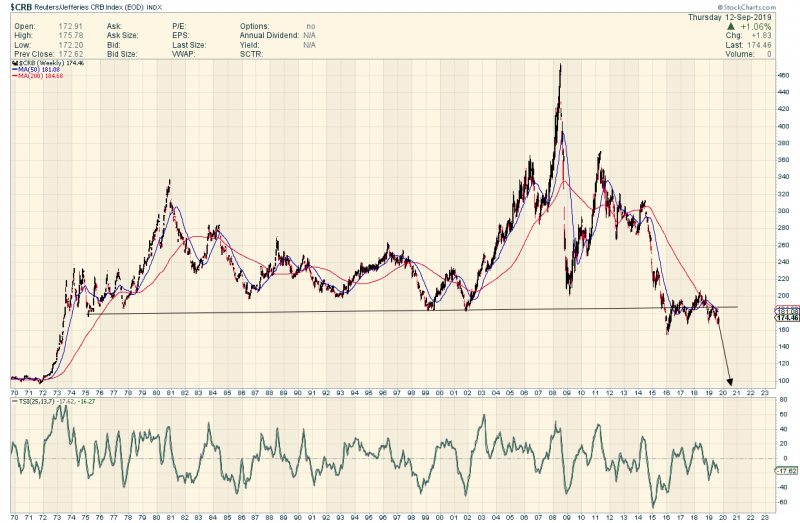Back to the Future
We have been looking at a chart for Commodities that shows the next move could be taking prices back to 1970’s prices .
Looks like Henry Hub Natural gas is There
https://seekingalpha.com/news/3499075-u-s-nat-gas-price-fall-lowest-levels-since-1970s-ihs-markit


Even without the potential big drop, commodity prices are now at an extreme low relative to everything else.
Talk about extreme manipulation of supposedly free markets. Only in a world run by central bankers.
I don’t think Central bankers Want to manipulate Commodity Prices LOWER Homer
There is a group you may have heard of who actually openly want to manipulate Oil Prices Higher …
Central bankers FEAR deflation. It is supposed to be EVIL !
IF they could manipulate Commodities Higher they would !
My bad, Fully. What I should have said was ‘Talk about extreme price distortions.’, rather than ‘Talk about extreme manipulation of supposedly free markets.’
However, if central bankers really fear Deflation that much, then why aren’t they supporting commodity prices on the futures markets?
How many more farms and mining companies have to go bankrupt before the price distortions are corrected?
A deflationary spiral was a major component of the prolonged crash of 1929…
Not an insider, I have no idea whether central banks manipulate these prices. Would the PRC never ever ever manipulate the Cu price during a trade war? I do not know. The central banks elsewhere would be pristine presumably in any case.
Would there be strong-arming by cartels of users to keep prices down? Anything like that? Would show prices be presented on exchanges in a deliberately misleading fashion while large volumes are bought and sold in quiet contracts? Would that count as manipulation? Do Chinese users communicate quietly with each other (conspire) to figure out ways to affect copper prices without a trade war? What about with a trade war? What about other users?
What about oil, gas? Would any government possibly try to affect the prices to hurt the economy of another government? Would cartels of users or producers (not necessarily public cartels) try to manipulate prices for their own good?
I don’t see how an outsider can be too sure much of the time.
Very well stated, Karl. You are way too kind and diplomatic. Also, perhaps a little bit tongue-in-cheek if I am reading you correctly.
Other big players that have been active in commodity futures trading are investment banks and bullion banks.
Whether or not these entities are doing the bidding of the governments, central banks and large corporations (or they are just operating for their own accounts) is an open question.
I currently don’t believe this analysis over 50-years, even though Plunger and Rambus also provide the same chart. The $CRB is heavily weighted in oil and not equally weighted across commodities. Also, ***ALL*** chartology charts are not dollar adjusted over time to some constant measurement, e.g., inflation is not removed … this is problematic the further one goes back in time when lines are drawn across charts. For example, when using an adjusted $Gold chart (using constant dollars from a chosen year) it looks like a massive cup-n-handle since the 1970s, similar to the un-adjusted silver chart.
With that in mind, Mike Oliver has a constant measurement across decades of time using his momentum oscillators. He now believes commodities have a massive 5.5+ year momentum structure (similar to what silver just broke out of) just above that if broken out of will send the price much higher and quickly. He also uses the equally weighted Bloomberg Commodity index, better than the $CRB. His number for this quarter for first breakout line is ~80 … which drops to ~79 next quarter. The massive structure comes out at ~85 this quarter. His current thesis is we are back in the 1970s where gold/silver led the charge, then commodities surged later.
Of course time will tell, but I have to remain open to someone’s judgement with arguably better tools, particularly for spotting massive and ripe momentum breakout structures who has also been on target for multiple years in a myriad of markets.
Another thing–you alluded to it–I nearly mentioned it before but held off since I’ve written it before–>an average can hide many things. The average of the world’s temperature may not change much over the year, but the temperature in Alberta might. The temperature on a mountain top in the Andes versus down in the jungle or desert way below might differ. Or in $ stuff, think real estate in East St Louis vs in Beverly Hills. I belabor the point.
To use my standard commodity example, look at nickel: http://www.kitcometals.com/charts/nickel_historical.html
….
My own opinion is that many commodities’ prices look horrible. They are likely to look worse. All of a sudden many people will wake up heavily on the wrong side of commodity trades, their complacency about “deflation” having done them in. Not today though. I’m not doing that bet though I do own some little base metal companies with (I hope) decent fundamentals.
You made some very good points, Afasilver.
Also, I do recall that there had been some changes in the way the $CRB index is calculated some years ago.
If we take a look at the historical price of copper, it was roughly $0.50 in late 1970 to early 1971, and this was a relatively low price at that time.
Today, nearly 50 years later, the price of copper is again quite depressed at around $2.60. That is roughly 5X the low price for 1970-1971 timeframe.
Although the price of copper did not keep pace with reported inflation here in the U.S., this comparison provides a less distorted picture than the $CRB index suggests.